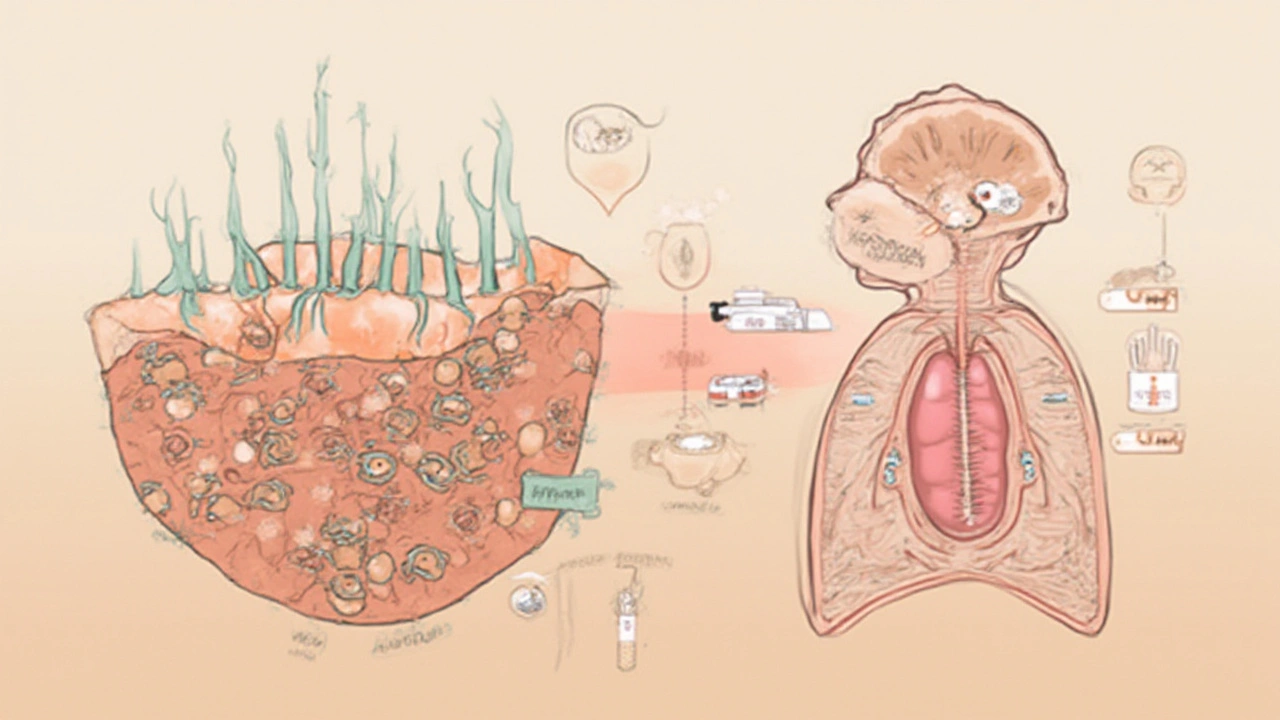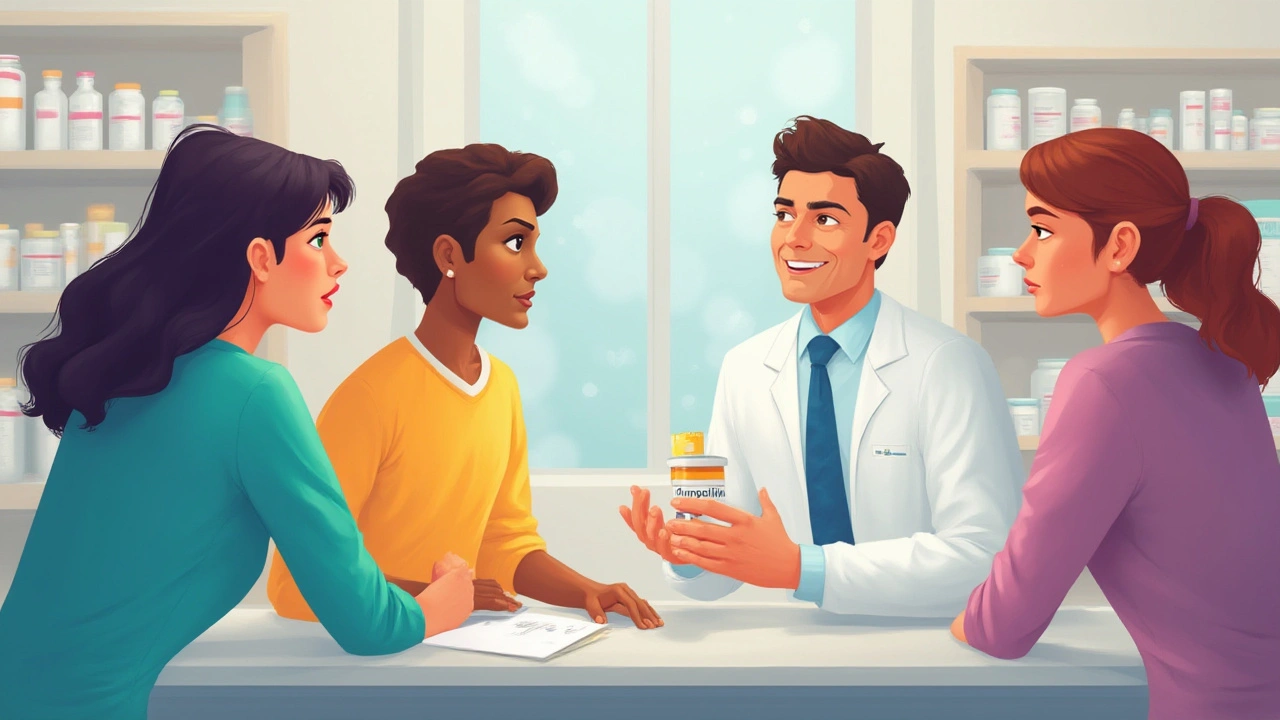Here’s something most people don’t realize: antibiotics like ampicillin have been quietly steering medicine for decades, shaping how we handle infections that once terrified our grandparents. Imagine being alive in a world where a sore throat or a scraped knee could lead to something really dangerous. That’s not some ancient history lesson. Until the late 20th century, simple bacterial invasions could take hold aggressively, and plenty of folks around Durban remember elders warning about “the fever” that swept through families. Yet, this little white pill, ampicillin, is so common that most of us barely think about it until there’s an infection in the family. Still, there’s much more to it than the pharmacy counter lets on.
How Ampicillin Works and What It’s Good For
If you stare down at a prescription bottle with “ampicillin” on the label, you’re probably battling an infection of some sort. Let’s make sense of that. Ampicillin belongs to the penicillin group, and it works by targeting the stuff bacteria build their walls from—think of a mason sabotaging a brick wall mid-construction. Without strong walls, bacteria basically pop and die out. That’s why it’s great at knocking back a range of infections; not viruses, though—that’s a common misunderstanding, but plain old colds won’t budge.
The main targets for ampicillin are infections like bronchitis, strep throat, pneumonia, bladder or urinary tract infections (UTIs), and even certain intestinal bugs like salmonella. Ever had a text from a friend saying they’re “down with tonsillitis again”? There’s a high chance they’ve been handed ampicillin, especially here in South Africa where group A strep and E. coli aren’t exactly rare visitors.
Doctors might choose ampicillin over other antibiotics simply because it’s broad-spectrum; it hits a wide range of bacteria and is less expensive than some fancy newer meds. For those with sensitive medical histories—think of people who react to sulfa drugs or macrolide antibiotics—ampicillin is usually a reliable fallback, as long as they’re not allergic to penicillin. Anyone with a penicillin allergy, though, is told in no uncertain terms to steer clear, no matter how nasty the infection is. That’s not just a formality—they could have a dangerous reaction, ranging from rashes to full-blown anaphylaxis, which is as scary as it sounds.
One cool fact: ampicillin’s approval in 1961 was a turning point because it could be taken orally, not just injected. Before that, many antibiotics needed a needle or hospital visit, and home treatment was rare. Now, swallowing a pill at the kitchen table is most people’s only brush with antibiotics. Still, sometimes hospitals use it intravenously when infections are tough or the patient can’t swallow pills, like in young children, elderly folks, or someone too sick to eat.
Veterinarians love ampicillin, too. Pets and even farm animals sometimes receive it—though this comes with controversy over antibiotic resistance, a point worth chewing over.

Smart Use, Side Effects, and What to Watch Out For
It’s tempting to think that if one pill is good, two might fix things faster. I’ve heard adults say things like, “I just wanted to be sure the bug was dead!”—but that’s exactly how bacteria learn to fight back and build resistance. South Africans, like many around the world, are being reminded by local clinics: finish the whole course, even if you feel fine after a couple of days. Stopping early just gives bacteria a practice round at evading the medicine.
Now, let’s talk side effects. Most people do fine on ampicillin, but hey, it’s still a medicine, and real side effects aren’t that rare. Keep an eye out for gut trouble: nausea, vomiting, diarrhea, and cramps. That’s because antibiotics sometimes kill off the friendly bacteria in our digestive tracts along with the germs causing trouble. If you find yourself heading for the bathroom a little too often, that could be why.
The more concerning stuff is allergy-related. Rashes are the classic sign, especially in children, but the symptoms can range from itchiness to swelling (especially of the lips, face, or tongue), and the truly bad reactions mess with breathing. Anyone with these symptoms after a dose should get emergency help, no questions asked. And don’t brush off those warnings about letting doctors know about any previous drug rashes or allergic experiences—in Durban clinics, nurses ask for a reason.
There’s also something that caught my attention in the latest batch of research: a study from Stellenbosch University found that a percentage of patients who took ampicillin for urinary tract infections developed a particular kind of antibiotic-associated diarrhea, known as C. difficile infection, which can be more than just annoying. It sometimes requires further treatment, so definitely flag prolonged or severe diarrhea to a healthcare worker.
Women sometimes report yeast infections after antibiotics, and it’s no myth. Without those friendly bacteria, yeast can flourish, causing discomfort, itching, and cottage cheese-like discharge. Using unscented soap, loose-fitting underwear, and probiotics with live cultures (found in many yogurts) can help reduce the risk, but if you spot symptoms, don’t tough it out. A visit to your GP is the quickest route back to comfort.
Mixing ampicillin with other medications can sometimes get tricky. Birth control pills, for instance, might become less effective. If you’re counting on them, extra protection for at least a week is essential—not just a scare story but a direct note on most pharmacist leaflets. If you’re taking blood thinners like warfarin, tell your doctor: ampicillin can alter how blood clots, so dose adjustments might be needed.
Ampicillin shouldn’t be the go-to for every sore throat or sniffle. Antibiotic resistance is a rising drama here in KwaZulu-Natal and everywhere else. Sometimes, doctors test to see exactly which bug is at work—called a culture and sensitivity—to make sure ampicillin will actually do the job, instead of reaching for it blindly. If you’re ever handed a small sterile cup or swab at the clinic, that’s what’s going on.

Tips for Safe and Effective Ampicillin Use
First thing’s first: follow the script, no freelancing with antibiotic doses. If your doc says four times a day, split the doses as evenly as possible, even if it means setting reminders—medicine doesn’t work better crammed into daylight hours. Ampicillin is best taken on an empty stomach, about half an hour before meals or two hours after. That’s because food can slow down its absorption, making it less effective, something nurses will mention during a busy clinic morning or at discharge from hospital.
If you miss a dose, all is not lost. Take it as soon as you remember unless you’re close to the next scheduled one. Never double up—two pills at once don’t cancel the mistake, they just up the risk of side effects. It’s a common slipup, but it's purely a myth that extra pills will “catch up the medicine.”
Store ampicillin in a cool, dry place, out of sunlight. Here in Durban, that means not leaving it by kitchen windows or in a hot car during summer. If you’ve got a liquid suspension for a child or elderly parent, keep it chilled in the fridge, and toss any leftovers after the course—refrigeration slows bacteria, but those homemade syrups don’t keep forever, and old medicine can be less effective or even unsafe.
- Finish the entire course, even if you feel better early on.
- Watch for signs of allergic reactions: rash, swelling, difficulty breathing.
- Use additional birth control if you’re on hormonal contraceptives.
- Eat yogurt or take probiotics to protect the gut during treatment.
- Don't share your antibiotics—everyone’s infection is different, and dosing matters.
Pregnant or breastfeeding? Ampicillin is relatively safe but only when the doctor sees fit. It passes through breast milk, so infants might develop a mild rash or gut upset. Don’t self-medicate—chat to your healthcare provider for the best plan.
Some interesting data from 2023: Public clinics here in eThekwini spearheaded a project teaching people about antibiotic stewardship, using posters in isiZulu and English. There was a 15% reduction in inappropriate antibiotic use in one year—a hopeful sign that smart public health campaigns really do make a difference. Simple steps like those above save more than just discomfort; they help keep ampicillin effective for generations to come.
Next time you grab that bottle, remember it’s not just a pill. It carries decades of medical doggedness, comes with safety challenges, and, if handled with respect, can get you back on your feet—or keep you from ever crawling there in the first place.
